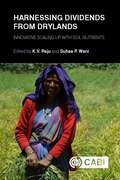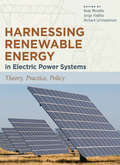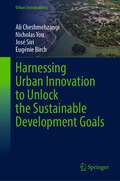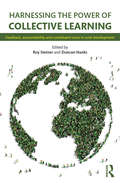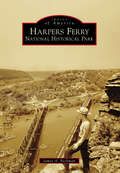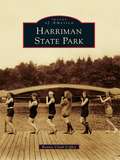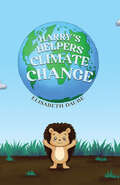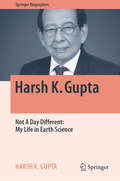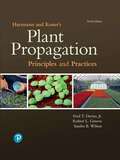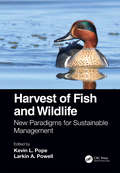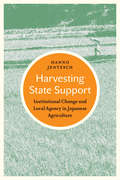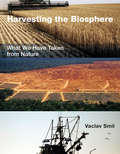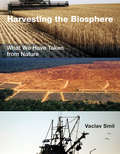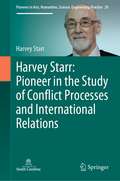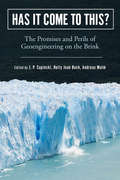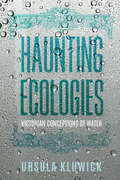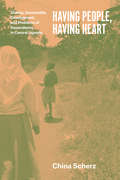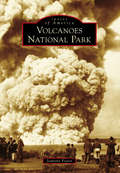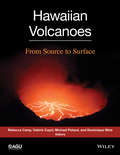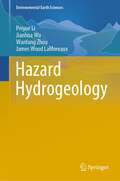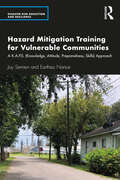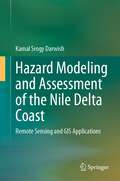- Table View
- List View
Harnessing Dividends From Drylands
by K. V. Raju Suhas P. WaniThe livelihoods of millions of people in developing countries depend on Dryland agriculture to ensure their food security and their well-being. Any improvement in yields for farmers in these areas will have a significant positive affect. This book describes lessons learned from an innovative scheme in India that improved yields in drylands. It shows how the scheme can be scaled up for other Dryland regions of the world. The scheme uses localized soil nutrient analyses to create an integrated, climate-smart fertilizer and planting plan that maximizes yields for farmers.
Harnessing Dividends from Drylands: Innovative Scaling up with Soil Nutrients
by Kanwar Sahrawat Gajanan Sawargaonkar Girish Chander A.V.R. Kesava Rao Kaushal Garg Mukund Patil G. Pardhasaradhi K Srinivas Raghavendra Sudi K. Krishnappa K. H. Anantha V. Nageswara RaoThe livelihoods of millions of people in developing countries, which depend on dryland agriculture to ensure their food security and their well-being, could be improved measurably by gains in agricultural crop yields. This book describes lessons learnt from an innovative scheme in India that improved crop yields in drylands. It shows how the scheme can be scaled up for other dryland regions of the world. The scheme uses localized soil nutrient analyses to create an integrated, climate smart fertilizer and planting plan that maximises yields for farmers. This book describes how a partnership between a global scientific organization (such as International Crops Research Institute for the Semi-Arid Tropics, ICRISAT) and state and non-state actors can provide a route to equitable growth, specifically for small and marginal farmers, and how this approach can be replicated worldwide to enhance rural livelihoods. This strategic collaboration and its conceptual and functional design is fully outlined, as well as the scheme's implementation and the effective monitoring and learning process that has been created.
Harnessing Foreign Investment to Promote Environmental Protection
by Jorge E. Viñuales Pierre-Marie DupuyHarnessing Foreign Investment to Promote Environmental Protection investigates the main challenges facing the implementation of environmental protection and the synergies between foreign investment and environmental protection. Adopting legal, economic and political perspectives, the contributing authors analyse the various incentives which encourage foreign investment into pro-environment projects (such as funds, project-finance, market mechanisms, payments-for-ecosystem services and insurance) and the safeguards against its potentially harmful effects (investment regulation, CSR and accountability mechanisms, contracts and codes of conduct).
Harnessing Renewable Energy in Electric Power Systems: Theory, Practice, Policy
by Richard Schmalensee Boaz Moselle Jorge PadillaReflecting its reliance on fossil fuels, the electric power industry produces the majority of the world's greenhouse gas emissions. The need for a revolution in the industry becomes further apparent given that 'decarbonization' means an increasing electrification of other sectors of the economy�in particular, through a switch from gasoline to electric vehicles. Of the options for producing electric power without significant greenhouse gas emissions, renewable energy is most attractive to policymakers, as it promises increased national self-reliance on energy supplies and the creation of new industries and jobs, without the safety and political concerns of nuclear power or the unproven technology of carbon capture and storage. Drawing on both economic theory and the experiences of the United States and EU member states, Harnessing Renewable Energy addresses the key questions surrounding renewable energy policies. How appropriate is the focus on renewable power as a primary tool for reducing greenhouse gas emissions? If renewable energy is given specific support, what form should that support take? What are the implications for power markets if renewable generation is widely adopted? Thorough and well-evidenced, this book will be of interest to a broad range of policymakers, the electric power industry, and economists who study energy and environmental issues.
Harnessing Urban Innovation to Unlock the Sustainable Development Goals (Urban Sustainability)
by Ali Cheshmehzangi Nicholas You José Siri Eugénie BirchThis book first attempts to explore the nexus between urban innovation and sustainable development goals (SDGs). It puts together global examples of urban innovation initiatives, highlighting practical, policy-oriented, social, and technological interventions. The case studies are divided into four clusters of ‘green cities’, ‘inclusive cities’, ‘resilient cities’, and ‘healthy cities’. In doing so, the book maps various global examples of urban innovation for sustainable pathways and directions. It also highlights means of implementation of tool and technologies, data, financing, and governance. The overarching aim is to provide a holistic overview of urban innovation sustainable development nexus, which would help future policy development, paradigm shifts, and technological applications.By summarising a selection of successful initiatives, interventions, and projects, this book highlights how urban innovation could accelerate achieving SDGs. The lessons learned from each case study cluster are narrated as knowledge transfer platforms for future city development and achieving sustainable development. These lessons will be beneficial to practitioners and governments, as well as researchers and academics who are interested in urban innovation research. City case studies included in the book are based on their success stories as role models for other cities in developed and developing nations. This collection helps us portray a more holistic image of urban innovation aligned with the SDGs and pathways to achieving them.
Harnessing the Power of Collective Learning: Feedback, accountability and constituent voice in rural development
by Roy Steiner Duncan HanksWhat were new ideas 30 years ago, such as the concepts of participatory development and systems thinking, are now accepted norms in international development circles. The majority of professionals engaged in rural development accept the proposition that the people who participate in development should play an active role in defining, implementing, and evaluating projects intended to improve their productivity and lives. However this goal remains unrealized in many development programs. Harnessing the Power of Collective Learning considers the challenges and potential of enabling collective learning in rural development initiatives. The book presents 11 case studies of organizations trying to develop and implement collective learning systems as an integral component of sustainable development practice. Through systematic reflection on action and experience, key lessons and themes emerge regarding the nature of voice, participation, feedback loops, accountability and transparency, that will be useful for many others in the development community. This book is a useful resource for academics, practitioners and policy makers in the areas of international development, sustainable development, organizational development, philanthropy, learning communities, monitoring and evaluation and rural development.
Harpers Ferry National Historical Park (Images of America)
by James A. BeckmanHarpers Ferry National Historical Park is a jewel of America's National Park Service. Established by legislation and signed into law by President Roosevelt in 1944, today the park encompasses thousands of acres spanning three states as well as the confluence of the Shenandoah and Potomac Rivers. While the town was ravaged by repeated floods and war, it rose like a phoenix from the ashes. As a Civil War soldier presciently wrote, "In future years travelers and tourists will eagerly resort [here] . . . and history will point out [this] spot where many acts of the great tragedy, not yet closed, took place." This book chronicles the creation and development of the national park in Harpers Ferry, a park that now affords hundreds of thousands of visitors each year the opportunity to marvel at the same scenery Thomas Jefferson said was worth a voyage across the Atlantic to see and to be able to walk the old streets where so many major acts of American history took place.
Harriman State Park
by Ronnie Clark CoffeyOnce home to Native Americans and mountain settlers, Harriman State Park is today a 73-square-mile wilderness and recreation area lying 30 miles north of New York City. Offering over 200 miles of hiking trails, swimming, boating, fishing, and camping, it has been an oasis for city dwellers for 100 years. During the 1800s, the land was home to hardworking farmers, miners, and woodcutters. As the new century dawned, it evolved into a park of stunning beauty. Part of the Palisades Interstate Park System, it is the second-largest state park in New York.
Harry's Helpers-Climate Change
by Elisabeth DaubeClimate Change made kid-friendly! Learn about causes and impacts of Climate Change! Discover nature and Earth’s diverse inhabitants! Learn how you can help save the Earth and become a Harry’s Helper! Engage in fun activities and experiments!
Harsh K. Gupta: Not A Day Different: My Life in Earth Science (Springer Biographies)
by Harsh K. GuptaThis book captures the essence of one of the most remarkable journeys of a professional who prevailed over numerous challenges and adverse situations that appeared before him from nowhere and how he emerged victorious to be hailed at a global forum of the American Geophysical Union in 2008. The author reflects upon the circumstances and times in post-independent India that threw him out of the comforts of a well-to-do family into the real world. He traces back his entry into the field of earthquake science and dwells at length upon the scope and freedom it offered for innovative thinking in the field with limitless opportunities. Mishaps and accidents paved the way to remarkable discoveries and achievements including the creation of the world record for establishing and populating India’s first permanent base station in Antarctica in a record time of one Antarctic summer despite having a near-fatal helicopter crash on 4th day after reaching Antarctica. Stressing the need to live safely with earthquakes as their short-term prediction is not a possibility yet, the author advocates a two-prong strategy of directly looking into the earthquake source region deep inside the earth and developing an earthquake-resilient society, simultaneously. He cites the success story of the Indian Tsunami Early Warning System that is operational in the Indian Ocean, today. The book inspires young professionals with a flair for challenges and a burning desire to achieve results at any cost. This book provides important information in a nutshell about artificial water reservoir triggered earthquakes, India’s building of the Dakshin Gangotri all-weather station in Antarctica, Indian Ocean Tsunami warning set-up, Low-Temperature Thermal Desalination, etc. The main objective of the book is to inspire a generation of young minds through a narration of scientific achievements that did not come easily to him. The aim is to tell them the difference between a reaction and a response to a given situation, the former being impulsive and irrational and the latter responsible and rational.
Hartmann and Kester's Plant Propagation: Principles and Practices
by Robert Geneve Sandra Wilson Hudson Hartmann Dale Kester Fred DaviesFor all undergraduate courses in plant propagation at the two-year and four-year colleges and universities. <p><p>The world standard for plant propagation and horticulture for over 50 years, Hartmann and Kester’s Plant Propagation continues to be the field’s most complete, up-to-date text on plant propagation. It now contains color figures throughout, promoting learning and making it an even more useful working text and reference. It also contains extensive updates reflecting the latest commercial techniques and understanding of propagation biology. Like previous editions, it is organized into paired chapters on principles and practices, so it can easily be adapted for teaching courses that cover only practical topics, and for courses that also cover conceptual issues.
Harvest of Fish and Wildlife: New Paradigms for Sustainable Management
by Kevin L. PopeHarvest of Fish and Wildlife: New Paradigms for Sustainable Management unites experts in wildlife and fishery sciences for an interdisciplinary overview of harvest management. This book presents unique insights for embracing the complete social-ecological system to ensure a sustainable future. It educates users on evolutionary and population dynamics; social and political influences; hunter and angler behavior; decision processes; impacts of regulations; and stakeholder involvement. Features: Written by twenty-four teams of leading scientists and managers. Promotes transparent justification for fishing and hunting regulations. Provides examples for integrating decision making into management. Emphasizes creativity in management by integrating art and science. This book appeals to population biologists, evolutionary biologists and social scientists. It is a key resource for on-the-ground managers and research scientists developing harvesting applications. As the book’s contributors explain: “Making decisions that are robust to uncertainty…is a paradigm shift with a lot of potential to improve outcomes for fish and wildlife populations.” –Andrew Tyre and Brigitte Tenhumberg “Temporal shifts in system states…must somehow be anticipated and dealt with to derive harvest policies that remain optimal in the long term.” –Michael Conroy “Proactive, effective management of sportspersons…will be essential in the new paradigm of harvest management.” –Matthew Gruntorad and Christopher Chizinski
Harvesting State Support: Institutional Change and Local Agency in Japanese Agriculture (Japan and Global Society)
by Hanno JentzschAgriculture has been among the toughest political battlegrounds in postwar Japan and represents an ideal case study in institutional stability and change. Inefficient land use and a rapidly aging workforce have long been undermining the economic viability of the agricultural sector. Yet vested interests in the small-scale, part-time agricultural production structure have obstructed major reforms. Change has instead occurred in more subtle ways. Since the mid-1990s, a gradual reform process has dismantled some of the core pillars of the postwar agricultural support and protection regime. Harvesting State Support analyzes this process by shifting the analytical focus to the local level. Drawing on extensive qualitative field research, Hanno Jentzsch investigates how local actors, including farmers, local governments, and local agricultural cooperatives, have translated abstract policies into local practice. Showing how local variants are constructed through recombining national reforms with the local informal institutional environment, Harvesting State Support reveals new links between agricultural reform and other shifts in Japan’s political economy.
Harvesting the Biosphere: What We Have Taken from Nature
by Vaclav SmilThe biosphere -- the Earth's thin layer of life -- dates from nearly four billion years ago, when the first simple organisms appeared. Many species have exerted enormous influence on the biosphere's character and productivity, but none has transformed the Earth in so many ways and on such a scale as Homo sapiens. In Harvesting the Biosphere, Vaclav Smil offers an interdisciplinary and quantitative account of human claims on the biosphere's stores of living matter, from prehistory to the present day. Smil examines all harvests -- from prehistoric man's hunting of megafauna to modern crop production -- and all uses of harvested biomass, including energy, food, and raw materials. Without harvesting of the biomass, Smil points out, there would be no story of human evolution and advancing civilization; but at the same time, the increasing extent and intensity of present-day biomass harvests are changing the very foundations of civilization's well-being.In his detailed and comprehensive account, Smil presents the best possible quantifications of past and current global losses in order to assess the evolution and extent of biomass harvests. Drawing on the latest work in disciplines ranging from anthropology to environmental science, Smil offers a valuable long-term, planet-wide perspective on human-caused environmental change.
Harvesting the Biosphere: What We Have Taken from Nature
by Vaclav SmilAn interdisciplinary and quantitative account of human claims on the biosphere's stores of living matter, from prehistoric hunting to modern energy production.The biosphere—the Earth's thin layer of life—dates from nearly four billion years ago, when the first simple organisms appeared. Many species have exerted enormous influence on the biosphere's character and productivity, but none has transformed the Earth in so many ways and on such a scale as Homo sapiens. In Harvesting the Biosphere, Vaclav Smil offers an interdisciplinary and quantitative account of human claims on the biosphere's stores of living matter, from prehistory to the present day. Smil examines all harvests—from prehistoric man's hunting of megafauna to modern crop production—and all uses of harvested biomass, including energy, food, and raw materials. Without harvesting of the biomass, Smil points out, there would be no story of human evolution and advancing civilization; but at the same time, the increasing extent and intensity of present-day biomass harvests are changing the very foundations of civilization's well-being.In his detailed and comprehensive account, Smil presents the best possible quantifications of past and current global losses in order to assess the evolution and extent of biomass harvests. Drawing on the latest work in disciplines ranging from anthropology to environmental science, Smil offers a valuable long-term, planet-wide perspective on human-caused environmental change.
Harvey Starr: Pioneer in the Study of Conflict Processes and International Relations (Pioneers in Arts, Humanities, Science, Engineering, Practice #29)
by Harvey StarrThis book sets out, through Starr’s personal story, his interest in how the ideas of “intellectual trajectories” and “political memories” could be incorporated into intellectual autobiography, thus exploring how the personal lives of individual academics intersected with their professional interests. By following the development of his approach to research, interdisciplinarity, the logic of inquiry, and the opportunity and willingness framework scholars and researchers will see how his groundbreaking research in Conflict Processes and International Relations Theory developed and were interlinked (especially diffusion, geography and spatiality; the democratic peace and integration; decision making). In addition, graduate students and junior faculty should find useful hints about how to navigate their way through the complexities of becoming both a professional and successful academic and scholar.• This book provides the most complete treatment of the work and contributions of Harvey Starr, a former President of the International Studies Association. • Important for contemporary students of international relations, and their understanding of IR theory and methods.• Demonstrates an eclectic linking of theoretical, logical, and empirical approaches to the study of IR—providing a critical logic of inquiry to do research.• Provides insights and blueprints for how to develop interdisciplinary and multidisciplinary scholarship, highlighting geography and social-psychology.• Affords graduate students and recent Ph.D.s guidance in the development of research, becoming a professional, and the choices to be made in one’s academic career.
Has It Come to This?: The Promises and Perils of Geoengineering on the Brink (Nature, Society, and Culture)
by Christian Parenti Richard York Jennie C. Stephens David Tyfield Laurence L. Delina Tina Sikka Nils Markusson Duncan McLaren Wim Carton Lili Fuhr Mads Dahl Gjefsen Ina Möller Anne Pasek Linda Schneider Kevin Surprise Kyle Powys WhyteGeoengineering is the deliberate and large-scale intervention in the Earth's climate system in an attempt to mitigate the adverse effects of global warming. Now that climate emergency is upon us, claims that geoengineering is inevitable are rapidly proliferating. How did we get into this situation where the most extreme path now seems a plausible development? Is it an accurate representation of where we are at? Who is this “we” who is talking? What options make it onto the table? Which are left out? Whom does geoengineering serve? Why is the ensemble of projects that goes by that name so salient, even though the community of researchers and advocates is remarkably small? These are some of the questions that the thinkers contributing to this volume are exploring from perspectives ranging from sociology and geography to ethics and Indigenous studies. The editors set out this diverse collection of voices not as a monolithic, unified take on geoengineering, but as a place where creative thinkers, students, and interested environmental and social justice advocates can explore nuanced ideas in more than 240 characters.
Haunting Ecologies: Victorian Conceptions of Water (Victorian Literature and Culture Series)
by Ursula KluwickVictorians&’ views of water and its role in how the social fabric of Victorian Britain was imagined Water matters like few other substances in people&’s daily lives. In the nineteenth century, it left its traces on politics, urban reform, and societal divisions, as well as on conceptualizations of gender roles. Drawing on the methodology of material ecocriticism, Ursula Kluwick&’s Haunting Ecologies argues that Victorian Britons were keenly aware of aquatic agency, recognizing water as an active force with the ability to infiltrate bodies and spaces. Kluwick reads works by canonical writers such as Braddon, Dickens, Stoker, and George Eliot alongside sanitary reform discourse, court cases, journalistic articles, satirical cartoons, technical drawings, paintings, and maps. This wide-ranging study sheds new light on Victorian-era anxieties about water contamination as well as on how certain wet landscapes such as sewers, rivers, and marshes became associated with moral corruption and crime. Applying ideas from the field of blue humanities to nineteenth-century texts, Haunting Ecologies argues for the relevance of realism as an Anthropocene form.
Having People, Having Heart: Charity, Sustainable Development, and Problems of Dependence in Central Uganda
by China ScherzBelieving that charity inadvertently legitimates social inequality and fosters dependence, many international development organizations have increasingly sought to replace material aid with efforts to build self-reliance and local institutions. But in some cultures--like those in rural Uganda, where Having People, Having Heart takes place--people see this shift not as an effort toward empowerment but as a suspect refusal to redistribute wealth. Exploring this conflict, China Scherz balances the negative assessments of charity that have led to this shift with the viewpoints of those who actually receive aid. Through detailed studies of two different orphan support organizations in Uganda, Scherz shows how many Ugandans view material forms of Catholic charity as deeply intertwined with their own ethics of care and exchange. With a detailed examination of this overlooked relationship in hand, she reassesses the generally assumed paradox of material aid as both promising independence and preventing it. The result is a sophisticated demonstration of the powerful role that anthropological concepts of exchange, value, personhood, and religion play in the politics of international aid and development.
Hawai'i Volcanoes National Park
by Jeanette FosterLocated in one of the most isolated places on the earth, thousands of miles from the nearest landmass, the area surrounding the Hawai'i Volcanoes National Park was created by violent earthquakes and fiery volcanic eruptions. Shrouded in ancient myth and legend, the park's history dates back to a time before the Hawaiians first arrived. It was a time when gods and goddesses roamed throughout these islands; the most famous, the fierce goddess of the volcanoes, Pele, is believed to live here still. It took a decade of lobbying efforts to finally preserve this unique area as Volcanoes National Park. Since 1916, not only has this area been a national park for all to experience, but also the scientific advances due to the ability to constantly monitor the volcanic activity here has had a huge impact on the science of volcanology, understanding earthquakes, and creating an early warning system for tsunamis.
Hawaiian Volcanoes: From Source to Surface
by Rebecca Carey Dominique Weis Valérie Cayol Michael PolandHawaiian Volcanoes, From Source to Surface is the outcome of an AGU Chapman Conference held on the Island of Hawai'i in August 2012. As such, this monograph contains a diversity of research results that highlight the current understanding of how Hawaiian volcanoes work and point out fundamental questions requiring additional exploration. Volume highlights include: Studies that span a range of depths within Earth, from the deep mantle to the atmosphere Methods that cross the disciplines of geochemistry, geology, and geophysics to address issues of fundamental importance to Hawai'i's volcanoes Data for use in comparisons with other volcanoes, which can benefit from, and contribute to, a better understanding of Hawai'i Discussions of the current issues that need to be addressed for a better understanding of Hawaiian volcanism Hawaiian Volcanoes, From Source to Surface will be a valuable resource not only for researchers studying basaltic volcanism and scientists generally interested in volcanoes, but also students beginning their careers in geosciences. This volume will also be of great interest to igneous petrologists, geochemists, and geophysicists.
Haystack
by Bonnie GeisertThe informative text brings to life a fascinating reminder of a working farm.
Hazard Hydrogeology (Environmental Earth Sciences)
by Wanfang Zhou Peiyue Li Jianhua Wu James Wood LaMoreauxThis book addresses geohazards by establishing their unique hydrogeological conceptual site models. Geohazards occur in many forms and scales either naturally or induced by human's activities. Many geohazards such as earth fissure, ground collapse and subsidence, mine water inrush, and groundwater contamination are closely related to hydrogeological conditions and their dynamics. Water, either surface water or groundwater, acts as a resource and an enabling agent that elevates geohazard risks in areas that are inherently vulnerable. The book presents case studies to describe identification and investigation methods, monitoring and early-warning techniques, modeling approaches, and engineering measures to prevent, control, and mitigate these geohazards. It targets students, researchers, practitioners, and decision makers who are engaged in water resource management, project planning, and geohazard control and management.
Hazard Mitigation Training for Vulnerable Communities: A K.A.P.S. (Knowledge, Attitude, Preparedness, Skills) Approach (Disaster Risk Reduction and Resilience)
by Joy Semien Earthea NanceThis book is designed to educate vulnerable communities, emergency practitioners, and disaster researchers to increase the social and physical capacity of communities to mitigate and adapt to disaster impacts. With climate change escalating the intensity and range of disasters, we have entered an unprecedented time. The tools in this book allow researchers, practitioners, and community leaders to adopt new training techniques that are more engaging and effective, using a bottom-up framework to integrate knowledge, attitude, preparedness, and skills (K.A.P.S). This book is uniquely designed to support instructors, researchers, practitioners, and community leaders in their effort to promote preparedness across marginalized communities. The book contains a full range of templates, worksheets, survey questions, background information, and guidance for carrying out training; the material has been field-validated to meet research standards. The K.A.P.S. Framework outlined throughout the book is designed to serve as an adaptable model that national and international audiences can utilize to better prepare their communities for disasters due to hurricanes, floods, and tornadoes. As climate change continues to ravage communities, the K.A.P.S. training program will prove to be an important tool for community trainers and academics across a range of hazards and disasters.
Hazard Modeling and Assessment of the Nile Delta Coast: Remote Sensing and GIS Applications
by Kamal Srogy DarwishThe book presents the results of a doctoral thesis conducted under the supervision of two international governmental universities in Egypt and the USA. This book is very important for specialists in the field of Physical Geography with concentration of Geographic Information Science and Remote Sensing techniques for Coastal Hazard Assessment. It deals with coastal hazards and disasters using unique techniques and methods, such as Coastline Change Detection, Sea-Level Rise Modeling and Future Predication, Coastal Erosion Hazard Mapping, and Coastal Vulnerability Index. The integration of geospatial technologies that applied accurately in this book especially for the coastal hazard mitigation and protection devise evaluation makes it very helpful for researchers and academics, as well as for coastal and civil engineers.
